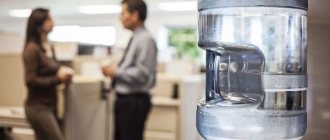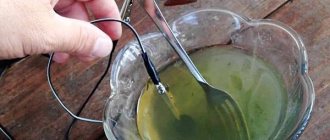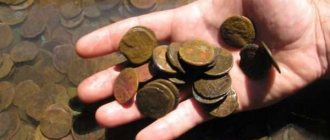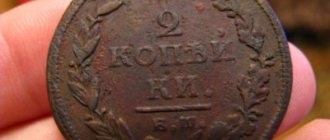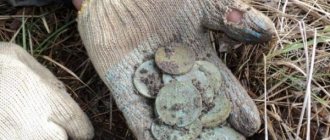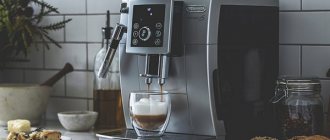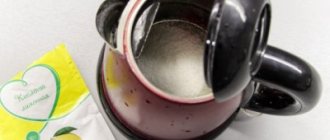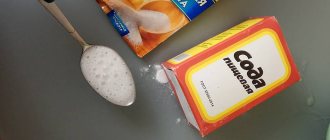10/29/201605/16/2017 Maria Ivanova
Cleaning coins at home is a simple set of works, the need for which is due to the oxidation of almost any metal over a certain period of time.
Those who know the specifics of various metals, in particular copper, gold, silver, etc., are aware of the fact that the older the coin, the more oxides appear on it.
When cleaning coins made of copper and other materials on your own, without turning to specialists, you need to follow simple rules to avoid causing damage to even the oldest coins.
Do we spend money on shopping or make do with what we have at hand?
Specialized solutions intended for cleaning procedures were developed taking into account the specifics of each specific metal: copper, silver, etc. Each of the products presented on the shelves of hardware stores allows you to remove various contaminants, uneven patina, and oxides from the surface of coins.
However, in an effort to restore copper and other metals to their original radiance and purity, not everyone can afford to purchase these rather expensive solutions.
Therefore, most ordinary consumers decide to tidy up the copper surface of coins using more accessible and less expensive means.
Alternative cleaning methods suitable for use at home can clean almost any dirty copper coin.
The list of necessary funds available in most households is as follows:
- "Coca Cola";
- lemon acid;
- soap;
- electrolysis.
With the help of each of them, many ordinary consumers were able to clean the copper surfaces of coins and other products made from this and other metals without unnecessary hassle.
The algorithm for cleaning coins made of copper and silver is characterized by the same simplicity and accessibility as for similar copper products. Numerous online resources contain all the necessary information.
The following review is devoted to the task of cleaning copper coins in various ways.
Cleaning coins with special means
Special household chemicals will help restore metal money to its original shine and purity. The products are available in the form of liquids or sprays and are effective, but require compliance with certain rules of use.
Cleaning algorithm:
- Read the instructions on the packaging and follow them carefully.
- Take the recommended safety measures - wear gloves, avoid contact of the product with skin or mucous membranes, and do not inhale fumes.
- Treat the fines with chemicals according to the instructions.
- After the set time has expired, rinse the product with water and dry.
Professional coin cleaners are highly effective and remove traces of corrosion, oxidation, and dirt in a few minutes.
The following products are especially popular: “Asidol-M”, Silbo, Leuchtturm, Shine Coins. With their help you can clean products made of gold, silver, copper, brass, bimetal . When choosing, consider the degree of contamination, the type of metal, and carefully read the instructions before use.
Citric acid for clean and shiny copper coins
The preparatory stage consists of searching and selecting a container, the possible material for which is:
- plastic;
- ceramics.
To clean copper coins, in addition to citric acid, you also need to prepare water. The acid is poured into a container and diluted with water. Coins are dropped into the solution.
It is necessary to take into account the fairly strong aggressiveness of the solution - the cleaning process must be carried out under continuous monitoring.
From time to time the product needs to be turned over. Carelessness and neglect of this requirement can lead to the fact that the solution can clean the coin right down to the metal.
After you have managed to clean the entire surface of the product, remove the contamination completely, it is advisable to create an artificial patina.
Safely clean old and collectible items at home
Products that can help with contamination on the surface of valuable specimens without causing harm include sweetened water and onion juice. Special formulations are most often made based on oil or petroleum jelly. After being in a liquid environment, coins should be wiped with a soft cloth. It is prohibited to use gels intended for washing dishes and plumbing fixtures.
The regularity of cleaning is determined by the numismatist himself. If he does not plan to sell coins, there is no urgent need for careful and expedited processing. Exhibits of particular value are recommended to be cleaned with special compounds. If you lack confidence in your own knowledge and experience, you should trust the professionals. Damaged coins in most cases cannot be restored.
Old products, unlike modern ones, are not protected from external influences. When cleaning, it is necessary to take into account that the strength of ancient products is greatly reduced. Therefore, when choosing a means for their treatment, you should give preference to gentle and safe preparations. How to clean old coins at home is indicated in the instructions that come with them.
How to clean quickly: 2 options with soap
Option #1
This cleaning method is considered to be as gentle and safe as possible for the item. As a rule, in this case, it is not household soap that is used, but neutral baby soap.
Having decided how to clean the coins, you must first grate the soap on a coarse or medium grater. Then the grated soap is diluted with a small amount of water until a homogeneous plastic mass is obtained.
To clean coins, they are inserted into the resulting soap mass. Having left the products in this state for some time, it is nevertheless necessary to periodically remove them from the water and check them, washing off layers of dirt and oxides.
Having decided to clean coins using this method, you need to understand such specifics of the approach as its impressive duration. The fact is that absolute cleansing in extreme cases can only be achieved after several weeks.
Option No. 2 (optional)
You can also achieve the desired goal by resorting to laundry soap. The process is somewhat different from the similar one described above, but it is also simple.
In this case, a plastic container is used as a container. It is filled with boiling water, into which soap shavings are poured.
After waiting for the soap to completely dissolve and obtain a jelly-like substance, the owner can dip copper coins into it, leaving it for a day or even two. The length of stay in the solution depends on the degree of contamination of the products.
After the required period of time has passed, the money must be washed using a soft brush and dried thoroughly.
Multiple repetitions of the procedure are allowed. By removing all the oxides layer by layer, you can get coins with an absolutely clean surface without any damage.
Mechanical method
Usually used in particularly advanced cases. In this case, the coin is literally cut out or reduced in a layer of oxides.
A simplified process looks like this:
- The surface layer of dirt deposits is removed from the coin, after which it is desalted in a container with distilled water.
- A layer of surface oxides (including loose ones) is impregnated with synthetic resin (B72).
- Using scrapers, cutters, brushes and needles of varying hardness, all excess is removed from the surface. The resin strengthens loose areas, binds them and prevents cavities from forming, which allows the surface to be leveled.
The work is performed under magnification (for example, a microscope). a successful result directly depends on a scrupulous attitude and experience, so it is better to entrust work with expensive items to a professional.
Fizzy Coca-Cola: Spend Money to Clean
The ambiguous properties of the drink, beloved by children and adults, have also found their application in the struggle for the purity and shine of hard coins.
Many people already know that it can be used to perfectly clean and shine the chrome surfaces of various products. Cleaning antique coins at home is no less successful.
So, to clean a dirty and tarnished coin, you need to put it in a container, preferably glass, and fill it with a fizzy drink. The dishes and their contents are left in this state for several days, preferably a week.
If you lack patience, the time required to clean coins can be significantly reduced. To do this, the dishes are placed on a radiator or other safe and effective heat source. The essence of the approach is that increasing the temperature speeds up the reaction.
It is possible to tidy up an old coin using the presented method due to the content of a small amount of orthophosphoric acid in the sweet drink. If the contamination is much more serious, you will have to resort to more radical methods.
Features of cleaning products made from different materials
When choosing a method and means of cleaning coins, it would be correct to take into account the material from which they are made. The right approach will quickly and effectively restore the product's shine without damaging it.
Gold and silver
Numismatists usually value items made of silver and gold. They require careful care and special storage conditions. Money made from precious metals should be stored separately from other banknotes, otherwise they will oxidize and will have to be washed much more often.
The correct choice of cleaning method and means will preserve the shine of gold coins and their value.
To clean gold and silver money, use gentle products, avoid aggressive substances and excessive mechanical impact.
Dry cleaning
You can wash stains on banknotes made of precious metals with a 10% ammonia solution. First, soak the products for several days in distilled water, and then for an hour in an ammonia solution. After the allotted time, rinse them and wipe dry.
When working with ammonia, take precautions: wear rubber gloves and open a window for ventilation.
Mechanical cleaning
Mechanical cleaning with brushes of different hardness will help remove minor dirt. To begin, soak the fines in distilled water for several days. Then polish it with a toothbrush, thoroughly cleaning the surface. To remove heavy stains, additionally use a mild soap solution.
Copper
You can clean copper coins using various means. The choice of method depends on the type of contamination. To remove red deposits, soak the fines in a 5% ammonia solution for 2 minutes. A solution of citric acid will help get rid of green stains, and acetic acid will help get rid of yellow stains.
To protect coppers from the negative effects of the environment, evenly cover them with patina - a special protective layer
After cleaning the coppers, perform the final stage of care:
- Rinse items with distilled water.
- Dry well with a napkin or soft towel.
- To create a protective layer, dissolve 50 g of copper sulfate in 1 liter of distilled water and add 5 g of potassium permanganate. Heat the mixture to +90 ℃.
- Dip the products into the solution and soak for several minutes. Turn them over periodically during processing so that the patina evenly covers the surface.
Nickel and bronze
Products made of nickel and bronze can be cleaned yourself at home, using improvised or special products.
Salt and vinegar
Step-by-step cleaning instructions:
- Prepare a solution based on table vinegar and salt.
- Soak nickel money in liquid.
- After soaking, treat the surface with an eraser and then polish with a soft cloth.
After cleaning, be sure to rinse the small items with running water and wipe dry with a soft cloth or
Trilon-B
For cleaning, prepare a glass container and Trilon-B product. Pour the powder into a container and add boiled water. Dip money into the solution, leave until the stains are completely cleaned, then dry and polish.
Bimetal
Bimetallic coins are an alloy of several metals. When choosing a cleaning method and means, it is important to consider the characteristics of each of them.
Electrolysis method
Those who paid due attention to physics lessons are familiar with this concept from school. Its usefulness when processing coins will be ensured if the following two important rules are observed:
- compliance with safety regulations;
- testing the method on inexpensive items in order to avoid damage to more valuable products.
It is worth paying special attention to the second point of the operating principles: the fact is that sometimes, due to a minor mistake, serious, irreparable damage is caused to a coin or other valuable item.
Old coins are restored to their purity and shine through the use of a small power supply (6-12 Volts). As such, a universal charger can be used. Another alternative: an old mobile phone charger.
The following are attached to the power supply or its alternative:
- two alligator clips;
- some small metal object (not copper or brass is recommended);
- deep dishes made of glass or ceramics.
A saline solution is also used, prepared in compliance with the following proportions: 1 tablespoon of salt per 1 liter of water.
The process is simple, you just need to follow all the steps exactly. One clip - with a minus sign - is attached to the specimen, while the opposite one - with a plus sign - is attached to a metal object.
Then the coin and the metal product are lowered into a pre-prepared container where the saline solution is located, while the power supply is plugged into the outlet.
The result makes itself known quite quickly: the process of dissolving oxides and dirt leads to rapid clouding of the solution. The “bathing” period is short, after which the specimen is washed with hot water and dried.
A little care and precision in following all steps will allow you to achieve the desired results.
"Oil" boiling
The method is quite effective and allows you to wash off the patina. It uses olive or vaseline oil, which is poured into a metal pan or deep fryer and heated. Coins are dipped into hot liquid and boiled for ten minutes, after which they are washed with soap and a soft brush.
Heat Vaseline or vegetable oil in a water bath. Immerse the fines in the hot liquid for 10 minutes.
Note! In some cases, additional boiling in clean water is necessary to remove residual oil.
Edge Cases
If the coin is brought to an extreme state: it is unusually heavily soiled, you can resort to caustic soda. The product must be handled very carefully; it must be diluted in cold water.
Since this product is inherently a strong alkali, it is recommended to avoid contact with it. You need to lower the product into this solution using tweezers. Residence time in the solution: no more than ten minutes, after which the coins are removed and washed.
However, not all coins can handle this method. If a green or blue stain is noticed on their surface, the cleansing process must be interrupted. If you have a negative reaction, you should not use this method on already tested products.
Having studied various methods of cleaning coins and choosing the optimal one, you need to maintain the accuracy of each step.
It is also necessary to take care of your own safety - especially when using certain methods.
Clean, shiny and sparkling coins delight both connoisseurs and connoisseurs of these products, as well as ordinary users who, for one reason or another, are interested in cleaning reused coins made of copper and other metals.
Causes of pollution
While in circulation, modern coins lose their presentable appearance over time. There are many reasons for this:
- moisture. Sweat on hands, getting into water, air humidity. All this negatively affects coins. A chemical reaction occurs with the metal, it oxidizes;
- household chemicals, acids, chlorine;
- air pollution - smog from car exhausts and various units;
- coin turnover. Coins in circulation have to come into contact with various substances (oil, acid, salts) on the hands. Also, contact with a hard surface may leave damage on them.
On ancient coins, contamination occurs mainly from prolonged exposure to soil, water or other aggressive environments.
Organic oil
Collectors use petroleum jelly or glycerin, but really anything will do: highly purified vegetable oil, cosmetic oil, or Johnson's Baby oil.
- Pour oil into a container and place a coin in it.
- Wait a week or two.
- Clean the copper with a scraper.
In this way you will remove minor plaque and darkening.
If soaking gives poor results, boil the coins in oil. This method is effective for cleaning well-preserved but dirty items. If you boil a heavily damaged coin, you will dissolve not only the plaque, but also the top layer of copper along with the coinage.
The coin is dipped into boiling oil for 5-7 minutes. During this time, the plaque turns into a sticky dense mass. Remove it with a brush and soapy water.
Soon you will have black but pure copper in your hands. Advice. The vapors from the oil are very flammable. During boiling, the container with oil must be covered with a lid.
Storage recommendations
After carrying out the cleaning process, the products are thoroughly washed and wiped dry with a cotton cloth. Especially valuable coins should be kept away from temperature changes and the sun. They try to pick them up carefully, without leaving traces. They are usually stored in a coin box - an album with sheets divided into standard square pockets for the collection.
If the patina of ancient coins was not intentionally damaged during the cleaning process, it can be replaced with an artificial one. To do this, place the object in a liquid of 10% hyposulfite for a short time, and the patina is restored.
Regular toothpaste
The simplest and relatively safe way to clean 10 ruble coins is to use ordinary toothpaste
. Moreover, the cheapest brand New Pearl or Colgate without additives in the form of crystals will do. The brush should be soft and hard to reduce the likelihood of scratches, and be sure not to bend. Otherwise, the process will drag on for a long time.
2-3 drops of paste are enough for one coin. Cleaning should begin under running warm water or in a small saucer of heated bottled drinking water. Under the tap, in 90% of cases it is chlorinated, which can later affect the quality. Dozens of plated ones begin to shine immediately. On bimetallic coins, the rim first becomes light, then the central part.
This method is excellent for cleaning coins from blackness and small deposits. Does not protect against rust and corrosion. When stored in a capsule or album, the shine remains for 4-5 months.
Stage 0 - Preview
Let's say it very loudly and clearly: any cleaning will not turn its object into a UNC condition coin. Even if there are no cavities or nicks on the coin, and the coin field begins to sparkle, the experienced eye of a collector or dealer will instantly distinguish it from the original shine inherent in specimens that have just left the territory of the mint. The price of a cleaned coin is much lower than the cost of its sister, found in the “Uncirculated” category. That’s why comments are so common on forums: “You just cleared half the value of a coin.” A beautiful patina for old coins is much preferable to an unnatural shine after diligent cleaning.
If you have an expensive item in your hands, you should not start cleaning it without sufficient experience. It is better to pay ten thousand to a specialist and get a coin that can start at one hundred thousand, than to find a twisted piece of metal that even a beginner would not want to add to the collection. Having two coins minted from the same metal - a rare one and an ordinary one - it is worth trying the cleaning method first on an ordinary coin and making sure that cleaning did not kill the coin or cause significant harm to it.
At this stage, we take and put aside all the coins of the “PROOF” design and with a polished coin field. These coins cannot be cleaned. Any impact is detrimental to them. Study the auction aisles (you can use the database on our website), and you will see how the smallest defect significantly reduces the price and forces most sellers to refuse to purchase a copy of less than perfect condition. If it seems to you that removing a small dark spot is easy and simple, then remember the parable of the monkey carrying peas and dropping the pea. Trying to pick it up, she dropped ten more. In an attempt to collect them, she scattered another hundred. Defects on a polished coin will grow in the same progression with the simplest cleaning. Yes, polished coins are cleaned by professionals, but that process is no longer closer to cleaning, but to restoration (which we will not touch on here).
If you still can’t wait to get started with polished coins, please read the article on our website “How to PROOF”.
